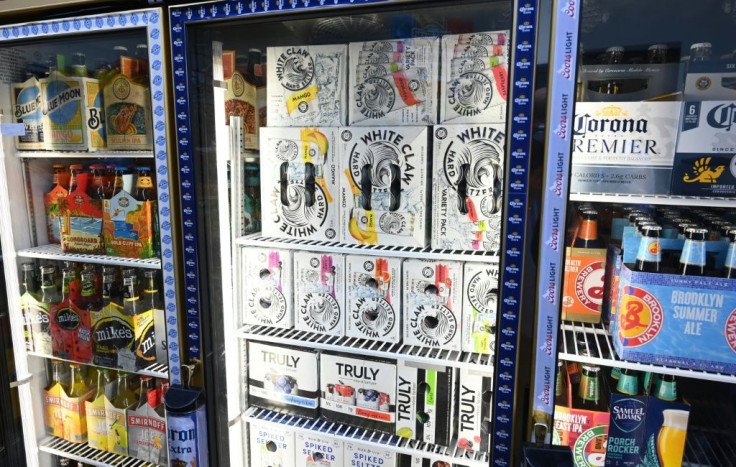Drinking In America: Shift From Traditional Alcohol To 'Healthier' Low Carb Drinks, Non-Alcoholic Beer And Marijuana Continue Amid Coronavirus

KEY POINTS
- Sales in the U.S. for traditional alcohol products like beer and wine continued its downward trend in 2020 amid the coronavirus pandemic
- The boom in "healther" alcoholic drinks like hard seltzers and slow growth of non-alcholic breweries continue thanks to a younger generation of drinkers
- Marijuana has also played a part as sales in states where it is legalized have remained strong
While the coronavirus pandemic has hit several industries hard, the drinks industry looks to be among the hardest hit. A combination of new trends and the pandemic created ripples most experts agree will take years for the industry to overcome.
“The pandemic is set to cause a deeper and more long-lasting aftereffect to the global drinks industry than anything we’ve experienced before,” IWSR Drinks Market Analysis Mark Meek told Bloomberg. “In many ways, 2019 was perhaps the last ‘normal’ year for the drinks industry.”
That’s not to say some people are drinking less. A survey released Monday by Kelton Global and Medical Technology and WEconnect indicated 57% of people making less than $50,000 a year have increased their alcoholic consumption. It also found 50% of people ages 25-54 admitted to drinking more than they were before the pandemic.
The reasons provided generally relate to stress and anxiety brought on by the pandemic.
“The pandemic has created an environment putting more people at risk,” WEconnect Health CEO Daniela Tudor said in a statement. “Now more than ever, the United States must urgently find evidence-based and creative approaches to meet this need amid COVID-19. This could exacerbate substance use disorders for years to come.”
While drinking may be up in these select groups, overall alcohol consumption continues to trend downward. IWSR said overall sales were down from 2019, which is reflected in falling sales for traditional beer, cider and wine.
One of the biggest contributors to this drop has been a push by younger drinkers to find low-carb alternatives that fit into a healthier lifestyle. This is reflected in the booming popularity of hard seltzers like White Claw and Truly over the last two years. The trend prompted major drink brands like Corona and Budweiser to release their own lines of hard seltzers to compete.
On average, a 12-ounce beer can have as many as 350 calories, depending on the kind of beer. Hard seltzers, by comparison, typically average around 100 calories for a 12-ounce drink while nonalcoholic beer has about 120 calories in a 12-ounce serving. Light beer has about 104 calories in a 12-ounce can.
Another trend emerging, though much smaller, has been a shift towards nonalcoholic beers. IWSR said coming into 2020, the category accounted for just 2% of sales in the U.S. beer market but was expected to grow by a third while traditional beer would drop 3.7%. This is credited to emerging breweries able to provide traditional beer tastes in non-alcoholic beers, something earlier nonalcoholic beers struggled to replicate.
In regards to calories, a 12oz. non-alcoholic beer will typically average around 60 calories.
Nonalcoholic brewer Athletic Brewing Co. CEO Bill Shufelt said 2020 sales already have surpassed 2019 sales despite the pandemic. He said the growth has allowed the Connecticut brewer to open a brewery in California and expand into the U.S. West and South.
“It’s an acceleration of a movement that was already in place,” Shufelt told Bloomberg.
Alcohol retailers can attest to these changing trends, as well. Total Wine, the biggest alcohol retailer in the U.S., has expanded the selection of “healthier” drinking options in their stores in the last two years.
Jonathan Bennett,Total Wine executive vice president for merchandising and supply chain, said the company noticed the shifting interest for several years, but the hard seltzer craze in 2019 forced the retailer to look for more low-calorie and nonalcoholic options. Bennett said most Total Wine locations had doubled the shelf space for nonalcoholic beers in 2020 and put up more signage promoting them.
“You can have the amazing taste experience of an IPA, but it just doesn’t have the alcohol in it,” Bennett told Bloomberg. “If this is going to be the end of alcohol, we’re going to be great at it.”
It’s also worth mentioning the part marijuana legalization has played in declining sales among traditional alcohol. By 2020, 11 states had legalized the sale and use of recreational marijuana with 22 states allowing the use of medical marijuana.
Illinois was among the most recent to legalize recreational marijuana use, with dispensaries opening for recreational sales Jan. 1. The Illinois Department of Financial and Professional Regulation said more than $44 million in marijuana products were sold in May, alone. Brightfield Group marijuana industry analyst Andy Seeger said May’s sale may have been higher had it not been for supply limitations caused by pandemic. These included delays in issuing new recreational licenses, closures of cultivation centers and dispensaries and increased demand for medical marijuana.
Several dispensaries across the state, most notably in Chicago, had to close as well for repairs in the wake of the first Black Lives Matter protests in June.
© Copyright IBTimes 2025. All rights reserved.



















